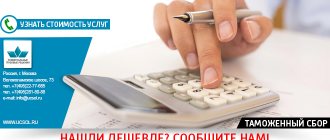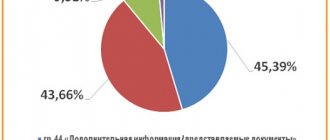Introductory information
Starting from July 2021, the Tax Code will contain a list of grounds on which inspectors can declare that reports have not been submitted (new clause 4.1 of Article of the Tax Code of the Russian Federation).
The list is closed, and one item is dedicated to the VAT return. If the control ratios are not met in the declaration submitted after July 1, 2021, then the tax authorities will recognize such a report as not submitted (for more information about the consequences, see “On what grounds will the tax authorities not accept reports submitted after July 1”). Determine the likelihood of an on-site tax audit and receive recommendations on the tax burden
The specified control ratios are listed in the Federal Tax Service order dated 05.25.21 No. ED-7-15-/ [email protected] (see “Control ratios have appeared for checking VAT returns submitted after July 1”). Let's figure out what the essence of each of them is.
What applies to fixed assets under the new standard
An object can be classified as fixed assets if it satisfies clause 4 of the standard:
- It has a material form. Previously, this criterion did not exist, although in practice it was implied.
- Intended for use by an organization in its normal activities, both commercial and non-commercial. In this case, the object may not actually be used. The new standard has added environmental protection to the list of possible areas for using fixed assets.
- The company expects to use the facility in the future for a long time:
- receive income with its help if we are talking about a commercial company;
- achieve the goals defined by the charter of the non-profit organization.
In general, the period of use of the object must be more than 12 months. If the business's operating cycle exceeds 12 months, then the organization must plan to use the facility for a period of time exceeding the operating cycle.
The new standard does not apply to the following accounting items, even if they have the listed characteristics (clause 6 of FSBU 6/2020):
1. Capital investments - a separate standard FSBU 26/2020 has been developed for them.
2. Long-term assets intended for resale. Such assets are accounted for in accordance with PBU 16/02.
The amount “payable” must be equal to the difference between the accrued VAT and the deduction
This condition is mandatory only for those whose accrued tax at the end of the quarter is greater than or equal to the deduction. How can I check this? Compare two figures from section 3 of the VAT return:
- on line 118;
- on line 190.
If the first digit is greater than or equal to the second, then the equality must be fulfilled:
| indicator from line 200 of section 3 | = | indicator from line 118 of section 3 | – | indicator from line 190 of section 3 |
Exchange a legally significant “primary” without leaving 1C
The amount “to be paid” must be equal to the difference between the accrued VAT and the tax “to be reimbursed”
This control ratio will be observed only if in the declaration the total amount “to be paid” is greater than or equal to the total amount “to be reimbursed”. To check this, you need to compare two numbers:
— sum of indicators: from line 200 of section 3; from line 130 of section 4; from line 160 of section 6;
- sum of indicators: from line 210 of section 3; from line 120 of section 4; from line 080 of section 5; from line 090 of section 5; from line 170 of section 6.
If the difference between the first and second digits is not less than zero, the equality must be satisfied:
| indicator from line 040 of section 1 | = | sum of indicators: from line 200 of section 3; from line 130 of section 4; from line 160 of section 6 | – | sum of indicators: from line 210 of section 3; from line 120 of section 4; from line 080 of section 5; from line 090 of section 5; from line 170 of section 6 |
Write-off of fixed assets
The new standard establishes the following reasons for writing off an asset in accounting (clause 40 of FSBU 6/2020):
1. Actual disposal: transfer to another person for any reason or physical loss, for example, due to a natural disaster.
2. Impossibility of further use, for example, due to the expiration of the maximum service life.
3. Loss of ability to generate economic benefits in the future. For example, an object is physically worn out, obsolete, or is no longer needed by the company due to the fact that the relevant activity has been discontinued. In this case, it is impossible to sell the object. In this case, the fixed asset must be dismantled or disposed of in another way.
Accumulated depreciation and impairment must be attributed to the reduction of the initial (revalued) cost of the object (clause 42 of FSBU 6/2020):
Dt 02 Kt 01.
If during the disposal process the organization received material assets, then their value also reduces the initial cost of the object:
Dt 10 Kt 01.
The remaining book value should be included as expenses for the period (clause 44 of FSBU 6/2020):
Dt 91.2 Kt 01.
Disposal costs are also generally written off against current expenses of the period (clause 43 of FSBU 6/2020):
Dt 91.2 Kt 60 (70, 69, 71...).
If an estimated liability was created for the disposal of a fixed asset item, then the disposal costs must be written off against this liability:
Dt 96 Kt 60 (70, 69, 71...).
Example 2.
The organization owns a truck. Initial cost - 800 thousand rubles, accumulated depreciation - 120 thousand rubles. After the accident, the head of the company decided not to restore the car, but to disassemble it for parts. The dismantling was carried out by a third party, the cost of the service was 50 thousand rubles. The cost of spare parts suitable for further use is 140 thousand rubles.
Dt 02 Kt 01 120 thousand rub. — the original cost is reduced by accumulated depreciation.
Dt 10 Kt 01 140 thousand rub. — the cost of the spare parts received is taken into account.
Dt 91.2 Kt 01 540 thousand rub. — the residual value of the car is written off as expenses.
Dt 91.2 Kt 60 50 thousand rub. — dismantling costs are taken into account.
The amount of VAT on incoming invoices must be equal to the total deduction from the purchase ledger
Let us remind you: the data from each incoming invoice is reflected in the corresponding lines of section 8 of the VAT return.
In particular, line 180 of this section indicates VAT on the invoice, or the difference in the amount of VAT on the adjustment invoice. The number of lines 180 corresponds to the number of invoices received from suppliers in the tax period (quarter).
The total amount of the deduction is reflected once - in line 190 of section 8 of the declaration.
Inspectors are required to ensure that the sum of the figures from all lines 180 equals the figure from line 190 of section 8.
Automatic reconciliation of invoices with counterparties will reduce the risk of additional VAT charges Carry out reconciliation
FSBU 6/2020 in detail
A gift for our readers - a recording of a webinar on the application of FSBU 6/2020. Two hours of detailed analysis of the innovations of the standard, specific examples and answers to questions! Speakers are well-known experts in accounting and participants in the development of new FSBUs:
- Alexey Ivanov is the director of knowledge and development of the online accounting system “My Business”.
- Lyudmila Arkhipkina is a leading methodologist for accounting and taxation of Internet accounting “My Business”.
In the “clarification”, the corrected deduction must be equal to the sum of the original value and all adjustments
When checking the updated VAT return, tax authorities will look to see whether Appendix No. 1 to Section 8 is filled out correctly. It is necessary that the adjusted deduction amount be made up of two components. The first is the original deduction value for the period being corrected. The second is the sum of all corrections made.
The reference ratio is as follows:
| indicator from line 005 of Appendix No. 1 to Section 8 | + | the sum of indicators for all lines 180 of Appendix No. 1 to Section 8 | = | indicator from line 190 of Appendix No. 1 to Section 8 |
The VAT amount on outgoing invoices must be equal to the total tax amount from the sales ledger
Information from each issued invoice is reflected in the corresponding lines of section 9 of the VAT return.
In particular, line 200 of this section indicates VAT on the invoice (the difference in the amount of VAT on the adjustment invoice) at a rate of 20%. The number of lines 200 corresponds to the number of invoices issued to customers, in which tax is allocated at a rate of 20%.
The final amount of VAT, accrued at a rate of 20%, is reflected once - in line 260 of section 9 of the declaration.
Inspectors are required to ensure that the sum of the figures from all lines 200 equals the figure from line 260 of section 9.
Similar control ratios are provided for other rates:
| For VAT rate 20% | ||
| the sum of indicators for all lines 200 of section 9 | = | indicator from line 260 of section 9 |
| For VAT rate 10% | ||
| the sum of indicators for all lines 210 of section 9 | = | indicator from line 270 of section 9 |
| For VAT rate 18% | ||
| the sum of indicators for all lines 205 of section 9 | = | indicator from line 265 of section 9 |
Connect to the system for exchanging electronic invoices
Valuation of fixed assets after recognition
There are two options for subsequent valuation of fixed assets after recognition (clause 13 of FSBU 6/2020):
1. Continue to evaluate the object at its original cost.
2. Use revalued value.
When choosing the revaluation option, the organization must regularly review the value of fixed assets so that it is equal to or close to fair value (clause 15 of FAS 6/2020). Fair value is determined in accordance with IFRS 13 Fair Value Measurement.
An organization can choose one of the subsequent valuation options for each group of fixed assets. Within the framework of the standard, a group is understood as a set of fixed assets with a similar nature of use (clause 11 of FSBU 6/2020). This could be, for example, real estate, transport, office equipment.
If an organization has investment real estate, then it must be separated into a separate group. We are talking about real estate that is intended for rental and (or) subsequent resale at a premium.
For fixed assets that do not belong to investment real estate, the following revaluation rules apply (clauses 16-20 FSBU 6/2020):
1. Revaluation can be made as the fair value changes, but not less than once a year.
2. There are two revaluation options:
- proportional recalculation of the original cost and accumulated depreciation;
- a reduction in cost by accumulated depreciation and subsequent adjustment to fair value.
3. The amount of revaluation of objects increases the additional capital:
Dt 01 Kt 83 - the cost of the operating system has been increased;
Dt 83 Kt 02 - depreciation is written off at the expense of additional capital.
4. The amount of the markdown is applied to the financial results of the period:
Dt 02 Kt 01 - the initial cost is reduced due to depreciation;
Dt 91.2 Kt 01 - additional markdown in excess of accumulated depreciation
Investment real estate is revalued according to separate rules (clause 21 of FSBU 6/2020):
1. It is necessary to revaluate at each reporting date.
2. The cost of an investment object after any revaluation must be equal to its fair value.
3. Both revaluation and depreciation of an object are included in the financial result:
Dt 03 Kt 91.1 - additional assessment;
Dt 91.2 Kt 03 - markdown.
In the “clarification”, the corrected VAT must be equal to the sum of the original value and all adjustments
When checking the updated VAT return, inspectors will find out whether Appendix No. 1 to Section 9 is filled out correctly. The goal is to make sure that the adjusted amount of the accrued tax consists of two components. The first is the initial value of VAT presented to buyers for the period being corrected. The second is the sum of all corrections made.
The control ratios for various rates are as follows:
| For VAT rate 20% | ||||
| indicator from line 050 of Appendix No. 1 to Section 9 | + | the sum of indicators for all lines 280 of Appendix No. 1 to Section 9 | = | indicator from line 340 of Appendix No. 1 to Section 9 |
| For VAT rate 10% | ||||
| indicator from line 060 of Appendix No. 1 to Section 9 | + | the sum of indicators for all lines 290 of Appendix No. 1 to Section 9 | = | indicator from line 350 of Appendix No. 1 to Section 9 |
| For VAT rate 18% | ||||
| indicator from line 055 of Appendix No. 1 to Section 9 | + | the sum of indicators for all lines 285 of Appendix No. 1 to Section 9 | = | indicator from line 345 of Appendix No. 1 to Section 9 |
Request a tax reconciliation report from the Federal Tax Service via the Internet Request for free
Valuation of fixed assets upon recognition
A new fixed asset item is valued at its original cost. This is the entire amount of capital investments associated with this facility (clause 12 of FSBU 6/2020).
The initial cost of the object includes estimated liabilities, for example, for the upcoming dismantling or restoration of the environment after the liquidation of the fixed asset. These estimated liabilities may change during the use of the property.
There are two options here (clause 23 of FSBU 6/2020):
1. If the estimated liability itself has changed, you need to change the initial cost of fixed assets.
2. If the present value of the obligation has changed, then the change must be attributed to other income or expenses of the period.
The organization must regularly check fixed assets for impairment in accordance with IAS 36 “Impairment of Assets” (clause 38 of FAS 6/2020). Signs that an asset is impaired include, for example, wear and tear, unfavorable market conditions, or the liquidation of the business for which it was acquired.
When testing for impairment of an asset, two quantities need to be assessed:
- fair value of the asset;
- expected cash flow from its use.
The value of the fixed asset item is adjusted to the higher of these estimates.
Impairment of fixed assets is included in other expenses. In accordance with paragraph 2 of the BMC recommendation dated 02.20.2015 No. R-56/2015-KpR, here you need to use correspondence with account 02, on which a separate sub-account should be created:
D 91.2 K 02.
Small businesses that maintain simplified accounting may not recalculate the value of fixed assets when estimated liabilities change and do not check fixed assets for impairment.
For tax agents using the simplified tax system: there should be no deductions in the declaration (applicable from January 2022)
In some cases, organizations and individual entrepreneurs are recognized as tax agents for VAT. This happens, in particular, if they rent federal or municipal property. Or they pay for goods (work, services) to foreign persons who are not registered for tax purposes in the Russian Federation (Article 161 of the Tax Code of the Russian Federation).
When transferring money, the tax agent is obliged to withhold VAT and transfer it to the budget. Further, as a general rule, he has the right to deduct input tax. But the deduction is not possible for everyone, but only for VAT payers. As for the “simplified” people, they cannot present it.
Find out OKVED, taxation system and income of your counterparty
VAT returns are submitted by all tax agents, including those using the simplified tax system. But the amount of the deduction presented should be zero. It is necessary to fulfill the equality:
| indicator from line 180 of section 8 | = | indicator from line 190 of section 8 | = | 0 |
There is one exception. It is designed for operations for the purchase of raw animal skins, scrap and waste of ferrous and non-ferrous metals, as well as waste paper. Such companies and individual entrepreneurs put code 1011715 in line 070 of section 2 of the declaration. Having seen this value, inspectors will not apply the above control ratio.
How to switch to FSBU 6/2020
Everyone who is obliged to use FSBU 6/2020 must switch to it no later than 01/01/2022 (clause 2 of Order of the Ministry of Finance dated 09/17/2020 No. 204n).
In general, organizations must switch to the new standard retrospectively (clause 48 of FSBU 6/2020), that is, according to the requirements of the new standard, recalculate all accounting information about existing fixed assets for past periods.
However, the standard also allows for a simplified transition option (clause 49 of FSBU 6/2020). In this case, the organization may not conduct a retrospective restatement for past periods. But you need to carry out the following operations at the same time as of 01/01/2022:
1. Identify objects that were previously accounted for as fixed assets, but according to the new rules should not be taken into account. For example, these are low-value fixed assets with a value below the limit. Their residual value must be written off to retained earnings:
Dt 84 Kt 01.
2. For all remaining fixed assets, recalculate depreciation taking into account the liquidation value, and also attribute the difference to retained earnings. The same operation applies to those objects that were not previously accounted for as fixed assets, but according to the new standard must be accounted for
Dt 02 Kt 84.
3. If an organization decides to keep records of all or individual groups of fixed assets at a revalued value, then in addition to adjusting depreciation, it is necessary to revaluate those assets to which this applies.
The selected transition option must be disclosed in the first financial statements prepared according to the new standard (clause 52 of FSBU 6/2020).
Example 3
The machine is listed on the company’s balance sheet as of December 31, 2021. Initial cost - 500 thousand rubles, accumulated depreciation - 100 thousand rubles, book value - 400 thousand rubles. The useful life is 5 years, the machine was actually used for 1 year.
The organization decided to set the liquidation value of the machine in the amount of 150 thousand rubles. Taking into account the adjustment, depreciation for 2021 should be equal to:
A = (500 thousand rubles – 150 thousand rubles) / 5 = 70 thousand rubles.
Book value:
B = 500 thousand rubles. – 70 thousand rubles. = 430 thousand rubles.
Thus, as a result of recalculation, the book value of the machine increased by 30 thousand rubles. This difference should be attributed to retained earnings:
Dt 02 Kt 84 30 thousand rub.
Small enterprises that maintain simplified accounting can switch to the new standard prospectively - without recalculating data for previous periods and balances at the beginning of 2022 (clause 51 of FSBU 6/2020).








